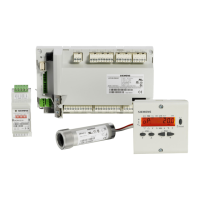283/301
Siemens Building Technologies Basic Documentation LMV5... CC1P7550en
HVAC Products 19 Addendum 4: LMV52... with O2 trim control and O2 module 13.08.2004
19.11 Commissioning the O2 trim control system
19.11.1 Setting ratio control
First, adjust the ratio curves as with the LMV51... system. The excess
O2 rate must be selected high enough, ensuring that, irrespective of
ambient conditions
(combustion chamber and fuel pressure, temperature
and pressure of the combustion air),
the O2 level will not fall below the O2
setpoint of O2 trim control.
Parameterize the loads at the curvepoints proportional to the effective fuel rate (amount
of fuel). For that purpose, ascertain the load with the help of the fuel counter.
The curvepoint identifies the smallest load where O2 trim control is still possible. In nor-
mal situations, this is the low-fire position. Point 1 defines the curve for reducing the air
rate below point 2. If, in the low-fire position, no further air reduction is possible (e.g. be-
cause the air damper has already fully closed), curvepoint 1 must be selected as the low-
fire point. In that case, O2 trim control will only be performed up to curvepoint 2.
The O
2 ratio value between the curvepoints should be linear. When O2 trim control is
activated, precontrol will transfer any nonlinearity to the actual O
2 value. When adjust-
ing the load, the actual O
2 value fluctuates about the O2 setpoint. Check the linearity of
the O
2 progression by approaching the loads between the curvepoints. If the O2 ratio
value has such nonlinearities, they can be corrected by setting intermediate curve-
points.
The more thoroughly the ratio curve is set, the easier the subsequent adjustment of O2
trim control, and the more accurate O2 trim control will be.
If the ratio curves are changed later, the O2 trim controller must also be
readjusted.
19.11.2 Setting the O2 monitor
Next, the O
2 monitor must be adjusted. When making the adjustment for the first time,
the O
2 monitor should remain deactivated to avoid undesired responses. When chang-
ing settings later, it can stay activated.
Set the O2 min. value as low as possible to ensure a high level of availability. The O2
min. value marks the boundary between the permanently non-harzardous range and
the potentially hazardous range.
Above or at the O2 min. value, hazardous conditions must not perma-
nently occur.
Guide values (for Europe): CO = 2,000 ppm, soot number 3.
The values vary, depending on the type of plant. They need to be checked.
After setting all O
2 min. values, the O2 monitor can be activated.
The setting can be made in 2 different ways.

